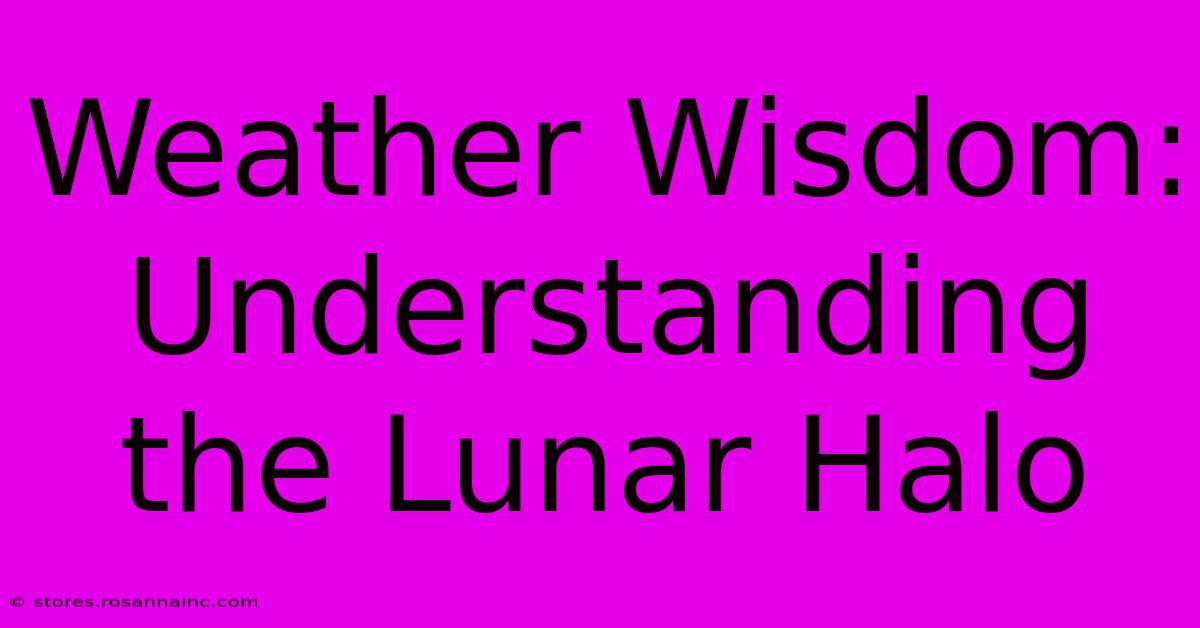Weather Wisdom: Understanding The Lunar Halo

Table of Contents
Weather Wisdom: Understanding the Lunar Halo
Have you ever looked up at the night sky and seen a luminous ring encircling the moon? This breathtaking celestial phenomenon is known as a lunar halo, a captivating display with a surprising connection to weather forecasting. Let's delve into the science behind this optical marvel and uncover its predictive power.
What is a Lunar Halo?
A lunar halo is a 22° halo, a ring of light appearing around the moon. Unlike a solar halo, which is often brighter and more easily visible, a lunar halo is more subtle, appearing as a faint, milky white or sometimes slightly colorful ring. Its ethereal beauty is a testament to the interplay of light and ice crystals in the Earth's atmosphere.
The Science Behind the Spectacle
The formation of a lunar halo is a fascinating process. It occurs when moonlight is refracted — bent — by millions of tiny ice crystals suspended high in the atmosphere, typically within cirrus clouds at altitudes of 5 to 10 kilometers (3 to 6 miles). These hexagonal ice crystals act as prisms, bending the moonlight and creating the halo effect.
The 22° angle is consistent because of the shape and orientation of the ice crystals. Light entering one face of the crystal and exiting another is refracted by a roughly 22-degree angle. This precise angle is what gives the halo its characteristic size.
Lunar Halos and Weather Predictions: Fact or Fiction?
While a lunar halo is a beautiful sight, many believe it holds predictive power regarding upcoming weather changes. This belief stems from a long-held association between the halo's appearance and the arrival of stormy weather.
The Connection to Approaching Storms
The presence of cirrus clouds, crucial for halo formation, often precedes the arrival of a warm front. These high-altitude clouds are often the leading edge of a larger weather system. As the warm front approaches, it pushes the cirrus clouds ahead of it, increasing the likelihood of halo formation.
Therefore, the appearance of a lunar halo can be a useful, though not foolproof, indicator of an approaching weather system. This doesn't mean a storm is guaranteed, but it does suggest a change in atmospheric conditions is on its way. The timing of the storm's arrival can vary, and the intensity of the storm can't be determined by the halo's appearance alone.
How to Observe a Lunar Halo
Observing a lunar halo is relatively simple, though it requires some patience and the right conditions:
- Dark Skies: The halo is much more noticeable in areas with minimal light pollution.
- Clear Skies (Partially): While cirrus clouds are needed, complete cloud cover will obscure the halo.
- Full or Nearly Full Moon: A brighter moon makes the halo more easily visible.
- Patience: Lunar halos are not always present and can appear and disappear relatively quickly.
Beyond the Weather: The Mystique of the Lunar Halo
Throughout history, lunar halos have captivated cultures worldwide, often being imbued with symbolic meaning and folklore. Some cultures viewed them as omens, while others saw them as beautiful celestial events. The mysterious and ethereal nature of the halo continues to inspire awe and wonder.
In conclusion: While a lunar halo's appearance can serve as a helpful weather clue, it's vital to remember that it's not a precise weather forecasting tool. It's a beautiful natural phenomenon resulting from the interaction of light and ice crystals, a reminder of the intricate processes occurring in our atmosphere. So, the next time you witness this celestial ring, take a moment to appreciate its beauty and the science behind it. Remember to check your local weather forecast for more accurate predictions!

Thank you for visiting our website wich cover about Weather Wisdom: Understanding The Lunar Halo. We hope the information provided has been useful to you. Feel free to contact us if you have any questions or need further assistance. See you next time and dont miss to bookmark.
Featured Posts
-
How Big Do Berkshire Pigs Get Homesteading Must Know
Feb 09, 2025
-
Rockets Drop Sixth Game Fall To Mavs
Feb 09, 2025
-
Giant Gecko Care Simple Steps For A Thriving Reptile
Feb 09, 2025
-
Bucks Vs Warriors Game Preview Feb 10
Feb 09, 2025
-
Beyond Confessions The Untold Story Of Augustine
Feb 09, 2025
